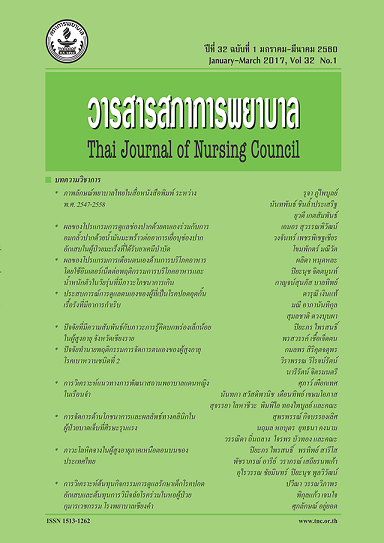ภาพลักษณ์พยาบาลไทยในสื่อหนังสือพิมพ์ ระหว่าง พ.ศ. 2547-2558; Image of Thai Nurses in Newspapers between 2004 and 2015
Keywords:
ภาพลักษณ์, พยาบาล, สื่อหนังสือพิมพ์, สื่อออนไลน์, การรับรู้, image, nurses, newspapers, on-line media, perceptionAbstract
วัตถุประสงค์ของการวิจัย: เพื่ออธิบายภาพลักษณ์ของพยาบาลไทย และแนวโน้ม การเปลี่ยนแปลงภาพลักษณ์ของพยาบาลในหนังสือพิมพ์ไทยและสื่อออนไลน์ ระหว่าง พ.ศ. 2547-2558
การออกแบบการวิจัย: การวิจัยเอกสารเชิงพรรณา การดำเนินการวิจัย: เอกสารที่ศึกษาได้แก่1) ข่าวหนังสือพิมพ์ที่ปรากฏในสิ่งพิมพ์ ไมโครฟิลม์ และข่าวออนไลน์ จำนวน 395 ข่าว วิเคราะห์ข้อมูลโดยการวิเคราะห์เนื้อหา
ผลการวิจัย : พบภาพลักษณ์พยาบาลในข่าวหนังสือพิมพ์และข่าวออนไลนม์ทั้งเชิงบวก และเชิงลบ ข่าวพยาบาลสะท้อนภาพลักษณ์ เป็นเชิงบวก 3 ด้าน และเชิงลบ 5 ด้าน โดยรวม พบว่าภาพลักษณ์เชิงบวกเน้นการบริการที่ดีมีประสิทธิภาพ มีการแสดงออกทางกริยามารยาท ที่ดีเป็นที่ประทับใจ เป็นผู้เสียสละ แต่ภาพลักษณ์เชิงลบมักเกี่ยวกับการบริการที่ไม่ประทับใจ คณุภาพชีวิตของพยาบาลที่ไม่ดี และไม่ก้าวหน้า พบว่าแนวโนม้ข่าวพยาบาลในหนังสือพิมพ์ เพิ่มขึ้นทั้งภาพลักษณ์เชิงบวกและเชิงลบ แต่ภาพลักษณ์เชิงลบมีจำนวนมากกว่าเชิงบวก
ข้อเสนอแนะ: ผู้วิจัยได้เสนอแนวทางในการพัฒนาภาพลักษณ์ของพยาบาลเชิงบวก ทั้งแนวรุกและแนวรับ ได้แก่ สถาบัน องค์กรวิชาชีพ สร้างกลไกการสื่อสาร ให้ข้อมูลแก่สื่อ เกี่ยวกับกิจกรรมของพยาบาลที่มีประโยชน์ต่อสาธารณะอย่างสม่ำเสมอและต่อเนื่อง ควรมี หน่วยงานหรือผู้ทำหน้าที่โฆษกของสถาบันวิชาชีพระดับประเทศที่ช่วยกระจายข่าวอย่างมี ประสิทธิภาพ แสดงจุดยืนที่เป็นผู้พิทักษ์สิทธิผู้บริโภคด้านสุขภาพ เพื่อให้สื่อสาธารณะรับรู้บทบาทพยาบาลที่เป็นฝ่ายประชาชนผู้รับบริการ ร่วมกับสื่อหนังสือพิมพ์ ในการให้ความรู้ ประชาชน และมีการให้ข้อมูลที่ถูกต้องเกี่ยวกับพยาบาล
Objective: To describe the image of Thai nurses in Thai newspapers and on-line media between 2004 and 2015, as well as its tendency to change. Design: Descriptive documentary research. Procedure: The data were 395 news reports from newspapers, microfilm and on-line sources. These reports were examined using the content analysis method. Results: The analysis of the on-line, microfilmed and newspaper reports showed 3 positive and 5 negative aspects of the image of Thai nurses. The 3 positive aspects were nurses’ (1) service efficiency; (2) polite, impressive manners; and (3) sacrificial attitude. The 5 negative aspects were mainly related to (1) the low standard of nurses’ quality of life; (2) patients’ dissatisfaction with nurses’ service; and (3) lack of nurses’ professional progress. In addition, despite an increase in both positive and negative aspects in newspapers and on-line media, the latter’s tendency to outgrow the former was observed. Recommendations: Both active and passive approaches were recommended by the researcher for the improvement of the image of Thai nurses. For these approaches to be effective, institutions and professional organisations need to collaborate in establishing communication mechanisms that provide the public with regular, consistent and up-to-date information on nurses’ publically beneficial activities. It is also recommended that an organisation or team of spokespeople be appointed by a national nursing profession institution to efficiently undertake publicity campaigns and to maintain nurses’ professional position to protect consumers’ healthcare-related rights. Through these efforts, public media—both on-line media and newspapers—can obtain a correct perception of nurses’ roles and provide the public with accurate information.








